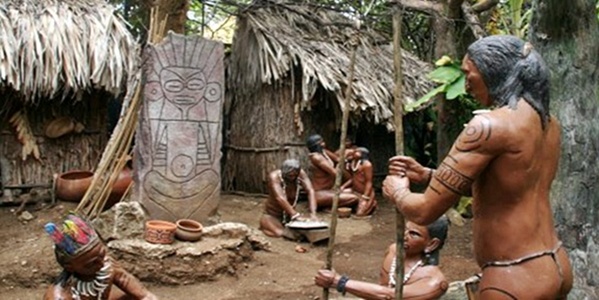Arawak Amerindians
The Arawaks lived in theocratic kingdoms, with a hierarchically arranged pantheon of gods, called zemis, and village chiefs, or caciques. The zemis were represented by icons of wood, stone, bones, and human remains.

Arawaks believed that being in the good graces of their zemis protected them from disease, hurricanes, or disaster in war. They therefore served cassava (manioc) bread as well as beverages and tobacco to their zemis as propitiatory offerings. The size of the community and the number of zemis he owned were directly related to the chief's importance.
Chiefs lived in rectangular huts, called bohios, while the regular members of the community lived in round huts, called caneyes. The construction of both types of building was the same: wooden frames, topped by straw, with earthen floor, and scant interior furnishing. But the buildings were strong enough to resist hurricanes.
From the European perspective, the wealth of the indigenous Indians was modest indeed. While Columbus and his successors sought gold and other trading commodities of value on the European market, the native Antilleans were not interested in trade and used gold only ornamentally.
Their personal possessions consisted of wooden stools with four legs and carved backs, approximately two-meter- long hammocks of cotton cloth or strings for sleeping, clay and wooden bowls for mixing and serving food, calabashes or gourds for drinking water and bailing out boats, and their most prized possession, large dugout canoes for transportation, fishing, and water sports. One such canoe found in Jamaica could transport about seventy-five persons.
Arawak villagers produced about two crops per year of manioc, maize, potatoes, peanuts, peppers, beans, and arrowroot. Cultivation was by the slash-and-burn method common throughout the Middle Americas, with the cultivated area's being abandoned after the harvest. The Indians worked the soil with sticks, called coas, and built earthen mounds in which they planted their crops. They might also have used fertilizers of ash, composted material, and feces to boost productivity. There is even evidence of simple irrigation in parts of southwestern Hispaniola.
Hunting and fishing were major activities. Arawaks hunted ducks, geese, parrots, iguanas, small rodents, and giant tree sloths. Parrots and a species of mute dog were domesticated. Most fishing, done by hand along the coast and in rivers, was for molluscs, lobsters, and turtles. Bigger fish were caught with baskets, spears, hooks, and nets. In some cases, fish were caught by attaching the hooks of sharpened sticks to a small sucking fish, called a remora, which fastened itself to larger fish such as sharks and turtles.
Food was prepared by baking on stones or barbecuing over an open fire, using peppers, herbs, and spices lavishly for both flavor and preservation. In some places, beer was brewed from maize. The descriptions of the first Europeans indicated that the food supply was sufficient and in general the inhabitants were well fed--until the increased demand of the new immigrants and the dislocation created by their imported animals created famine.
 Skip Nav
Skip Nav